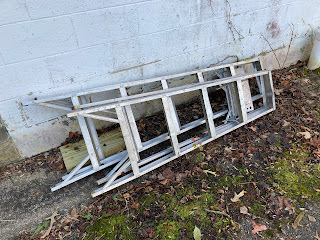I said a year ago that for me, 2021 began with hope. I end it the same way, with hope and gratitude.
This blog soldiers along at a slow pace these days, as I've many obligations--writerly and otherwise--to fill my hours. But it would be remiss if I did not pause in the final hours of a gone year to give thanks. It makes a lot of sense, instead of drinking too much and then sounding a noise-maker at the stroke of midnight.
So what am I thankful for, in the Tractorpunk scheme of things?
First, that my wife and I have the health to continue our DIY lives. In spite of a fall for her and arthritis for me, we still remain flexible, strong, and active. Today I moved 600 pounds of chicken feed into storage, after we made a trip to the factory where it is made in the Shenandoah Valley. I'm thankful we found that factory, to cut our operating costs for non-GMO chicken feed. Yes, we must raise egg prices in 2022, but not by the margin we feared, once inflation reared its ugly head.
I'm also thankful that my DIY skills continue to ramp up. I replaced the wire harnesses on our old John Deere M tractor and rebuilt the carburetor for the second time in a decade. With electronic ignition and all that includes, the 70-year-old beast still can mow the grass as well as when it was new. The work left the machine down for months and that delay had its frustrations, but in the end, I learned a lot. That's the satisfaction of much mechanical work.
Beyond that, I'm finishing the year by putting old-fashioned wood weatherboard siding to replace some of the vinyl on our house. I planed it myself, from wood my brother-in-law sawed, from logs of trees my late father-in-law felled. From tree to board, in one family. We are not Amish (lots of power tools got employed) but there are few manual joys to rival making your own building materials. Eventually all the vinyl siding will be gone: cement board will replace some in hard-to-paint places, but where I have wood available, that will go up instead.
Third, I'm thankful that my wife could retire. So many of my friends cannot contemplate retiring, but our rather frugal lives and my day job, plus the miracle of compounded interest, let Nancy leave full-time teaching July 1. It has been a rough semester for her colleagues with COVID and a return to school of children not accustomed to sitting in a classroom for a few semesters. Now Nan can focus on her tasks with our LLC and do some part-time work for the school system, as I drift toward retirement in a few years. I'm planning to get a first-year writing textbook published, which is no easy task in this publishing market, but at the same time, I've published pieces in Style Weekly, back from the grave thanks to a purchase by Virginia Public Media. I've also written for Hemmings Daily and Modeling Madness (plastic models, not insane fashionistas).
Finally, I'm thankful for the locally owned businesses that have weathered the pandemic. Good Foods Grocery expanded and diversified its selection of foods, and it offers a quieter alternative to Ellwood Thompson's, another favorite. Several restaurants we love hung in despite the virus and labor shortages, and most of our favorites have been recently crowded, including the Athens Tavern, where we held our rehearsal dinner in 1992. We have a new local hardware store, too, to compete with Pleasants. Then we discovered a fabric store just down the street for projects, too. At Virginia Beach, we found The Barclay Cottage B&B where we found gracious hosts for a short getaway. We met a second farm-sitter, too, to help with the animals when we are away.
Not everything we love endured, of course. Our favorite wine store, Sonnys, shut its doors a few months ago, but that was more due to a greedy out-of-state landlord than anything else.Drive through Richmond, and you'd find more than few old businesses shuttered.
So we should count the losses, but at the same time, I'd start by counting what endures. There's a lot to fix, but we start where we can: locally.
Maybe that process can begin in 2022.
Sunset image from Wikipedia

















